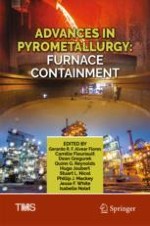This collection explores the methods and challenges of containing corrosive and abrasive materials at extreme temperatures, whether they are used across commodities or technology specific. There is much to be learned from cross-commodity and cross-technology perspectives and this collection creates a platform for the exchange of ideas on the challenges, solutions, failures, and successes in furnace containment designs and applications while bringing together perspectives from industry, design houses, and research institutions. Topics include, but are not limited to:
· Advances in furnace lining design philosophies
· Advances in furnace design configurations and other design considerations
· Problems experienced and their solutions implemented during construction and commissioning
· Integration of new concepts into old smelters
· Back to basics: refractory materials, shells, and cooling systems
· Maintaining and monitoring
· Process control and slag design
· Lessons learned
